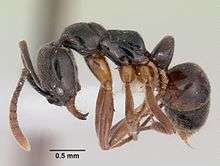Brachyponera chinensis
| Brachyponera chinensis | |
|---|---|
 | |
| B. chinensis worker from the United States | |
| Scientific classification | |
| Kingdom: | Animalia |
| Phylum: | Arthropoda |
| Class: | Insecta |
| Order: | Hymenoptera |
| Family: | Formicidae |
| Subfamily: | Ponerinae |
| Genus: | Brachyponera |
| Species: | B. chinensis |
| Binomial name | |
| Brachyponera chinensis (Emery, 1895) | |
Brachyponera chinensis, or the Asian needle ant, is a ponerine ant native to areas of Japan and Asia.[1] The species can also be found in the United States,[2] where it is an adventive and possibly invasive species. It is documented from Georgia, North Carolina, South Carolina, and Virginia, though unpublished records place it in Alabama and Tennessee.[3] Sightings have been confirmed as far north as Maryland. [4] The pest species is of growing concern due to ecological impacts on biodiversity[5] and medical risks to human health, via sting-induced anaphylaxis.[1] It prefers nesting in dark, damp areas in soil beneath stones, logs, stumps, and debris.[3]
The Asian needle ant and the Argentine ant (Linepithema humile) have been battling for territory in the U.S.[6]
References
- 1 2 Mark P. Nelder, Eric S. Paysen, Patricia A. Zungoli & Eric P. Benson (2006). "Emergence of the introduced ant Pachycondyla chinensis (Formicidae: Ponerinae) as a public health threat in the southeastern United States". Journal of Medical Entomology. 43 (5): 1094–1098. doi:10.1603/0022-2585(2006)43[1094:EOTIAP]2.0.CO;2. PMID 17017251.
- ↑ Joe MacGown. "Ants (Formicidae) of the southeastern United States". Mississippi Entomological Museum. Retrieved 18 April 2011.
- 1 2 Pat Zungoli. "Asian needle ant, Pachycondyla chinensis (Emery)". Household & Structural Urban Entomology. Clemson University. Retrieved 18 April 2011.
- ↑ "Maryland Biodiversity Project - Asian Needle Ant (Brachyponera chinensis)". www.marylandbiodiversity.com. Retrieved 2016-09-28.
- ↑ Benoit Guénard & Robert R. Dunn (2010). "A new (old), invasive ant in the hardwood forests of eastern North America and its potentially widespread impacts". PLoS ONE. 5 (7): e11614. doi:10.1371/journal.pone.0011614. PMC 2908120
 . PMID 20657769.
. PMID 20657769. - ↑ Ants Misbehaving: Argentine and Asian Ants Battle for U.S. Dominance; "In a fierce battle for dominance, Asian needle ants are displacing other species and threatening U.S. ecosystems" May 5, 2013 Scientific American
External links
 Media related to Brachyponera chinensis at Wikimedia Commons
Media related to Brachyponera chinensis at Wikimedia Commons